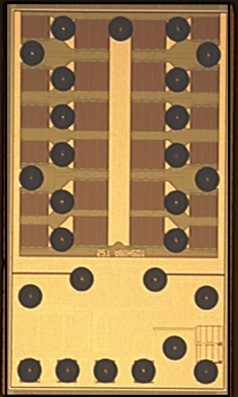Contributes to performance improvement of smartphones by using new generation “TaRF6” process
TOKYO — (BUSINESS WIRE) — September 10, 2014 — Toshiba Corporation (TOKYO:6502) today announced that it has developed SP12T[1] RF antenna switch ICs for smartphones supporting LTE-Advanced that achieve the lowest-level insertion loss[2,4] and RF distortion[3,4] in the industry. Sample shipment starts from today.

Toshiba: SP12T RF Antenna Switch IC (Photo: Business Wire)
With the spread of mobile communications, the number of RF bands and data speed rates is increasing dramatically. Requirements for antenna switch ICs, which are used in the RF circuits of mobile devices, are leaning towards multi-port and improvements to RF performance, including insertion loss and linearity. In addition, in order to meet the drastic growth of high data rate mobile communication devices in emerging markets, it is necessary to achieve these RF performance improvements in a cost-effective method.
In responding to these requirements, Toshiba has developed “TaRF6”, a new generation TarfSOITM (Toshiba advanced RF SOI) [5] process using silicon-on-insulator (SOI) technology[6]. TarfSOITM achieves integration of analog, digital and RF circuits on a single chip. Compared to other conventional solutions, such as GaAs, it delivers a cost-effective solution that supports highly complex switching functions and RF performance.
With the new “TaRF6” process, MOSFETs customized for RF switch applications have been developed and used in the new SP12T RF antenna switch IC, leading to a performance of 0.42dB in insertion loss (f=2.7GHz) and -90dBm in second harmonic distortion[7]. Compared to products using the previous “TaRF5” process, there is a 0.26dB improvement in insertion loss (f=2.7GHz) and 18dB improvement in second harmonic distortion. The lower insertion loss can contribute to low power consumption of smartphones, while the lower distortion can contribute to the development of carrier aggregation[8] smartphones that require low distortion.
Toshiba will expand the product line-up using the “TaRF6” process with low insertion loss and low distortion by the end of the year, to meet the requirements for multi-port and complex functions demanded in LTE now being implemented worldwide, and LTE-Advanced[9] expected to follow. Furthermore, Toshiba is considering offering SOI foundry services using TarfSOITM technology.
| Notes | ||
| [1] | Single Pole Twelve Throw Switch | |
| [2] | The loss of electric power that occurs when current goes from one terminal to another in a radio frequency circuit, expressed in decibels. | |
| [3] | Unnecessary frequency components that appear in the output signal when current goes from one terminal to another in a radio frequency circuit. | |
| [4] | In the RF antenna switch market as of September 10, 2014. Toshiba survey. | |
| [5] | TarfSOITM is a trademark of Toshiba Corporation. | |
| [6] | The technology forms an insulation film under the channel of the MOSFET and reduces stray capacity to improve speed and power saving of the CMOS LSI. | |
| [7] | Distortion component with twice the frequency. | |
| [8] |
A technique to increase the transmission data rate using multiple frequency carriers simultaneously. The smaller harmonic performance is required for this application to avoid the degradation of receiving performance by the harmonics component which overlaps on the receiver band. |
|
| [9] | A new communication standard developed by the 3GPP standard development organization. One of the fourth generation mobile communication systems defined by the ITU. | |

